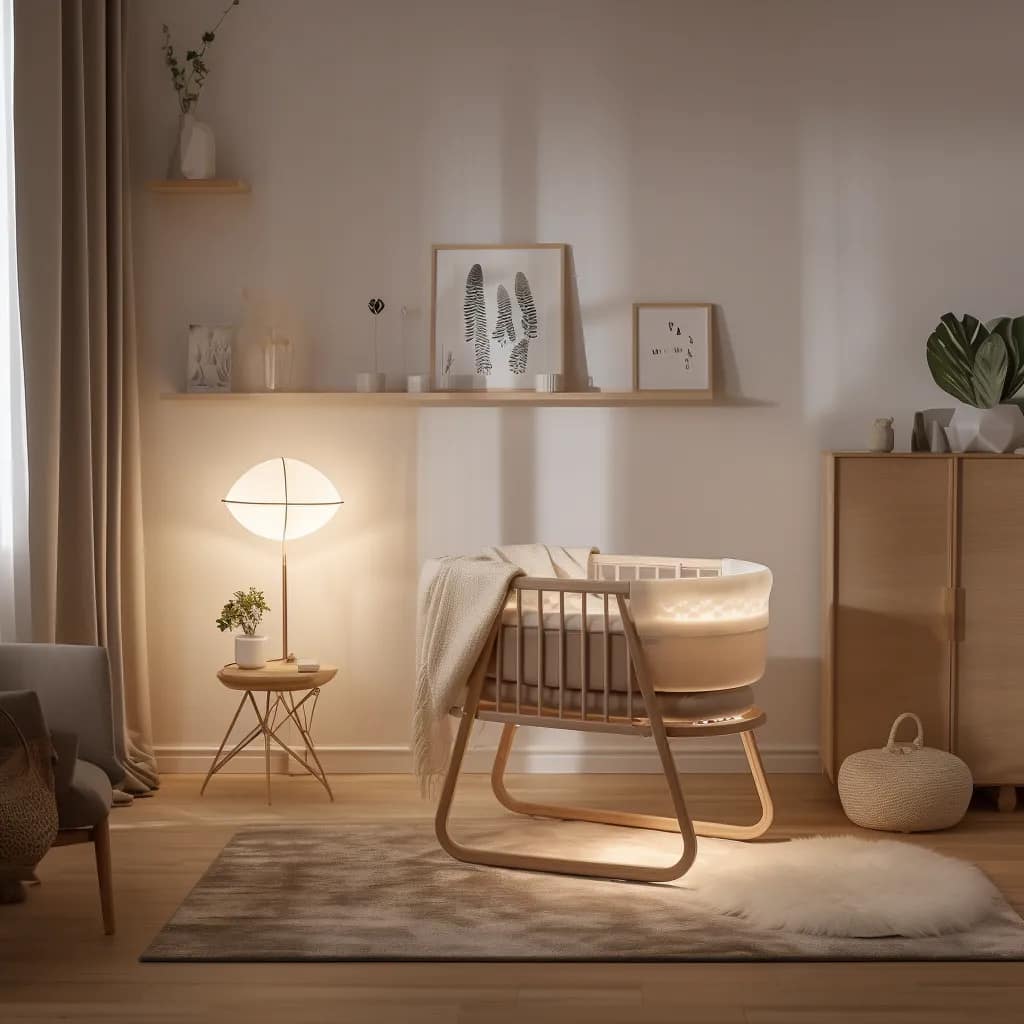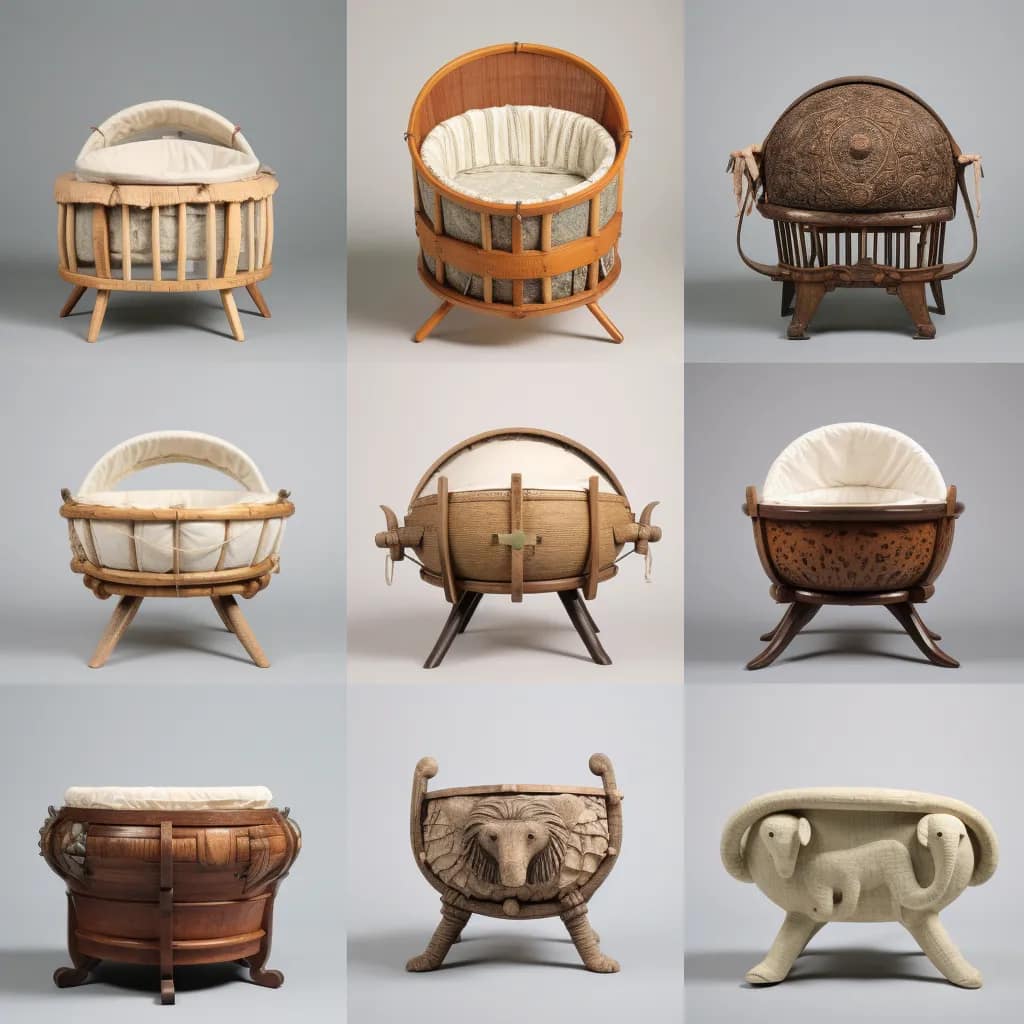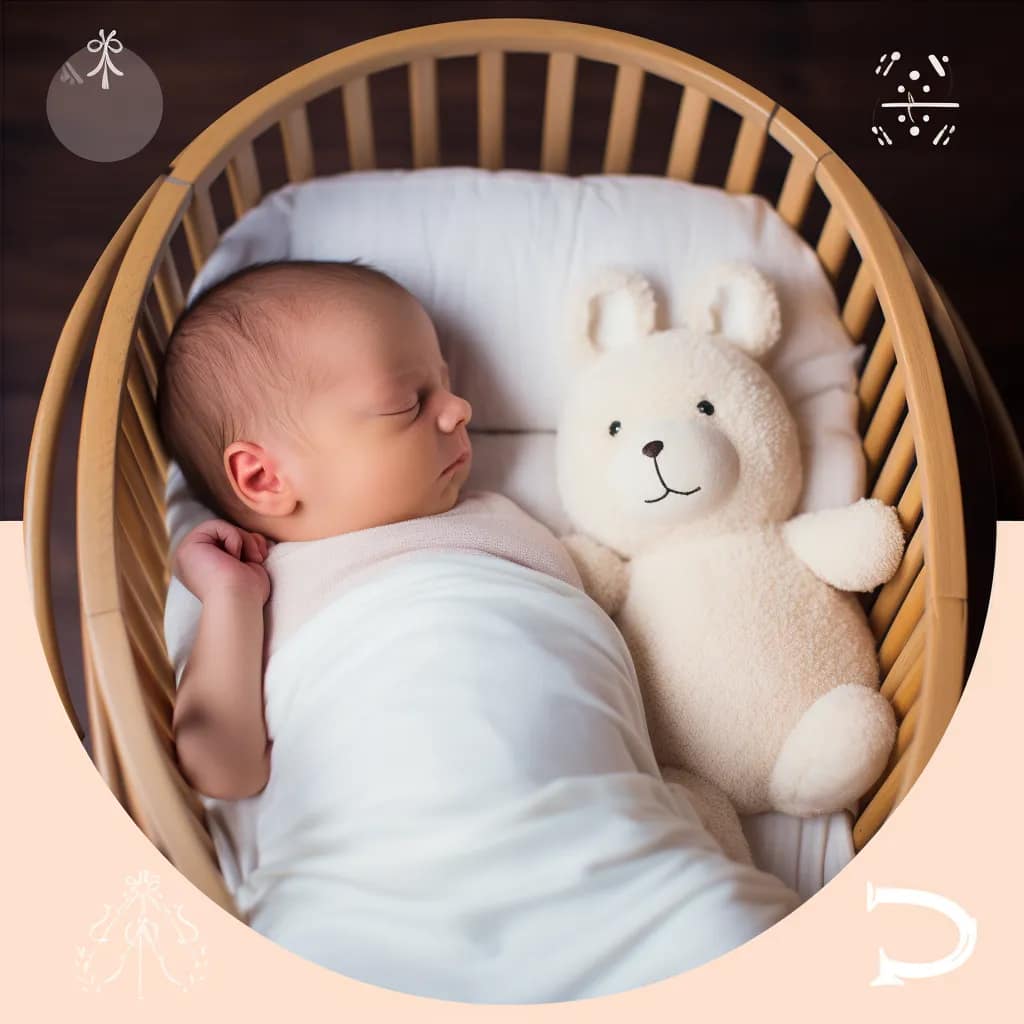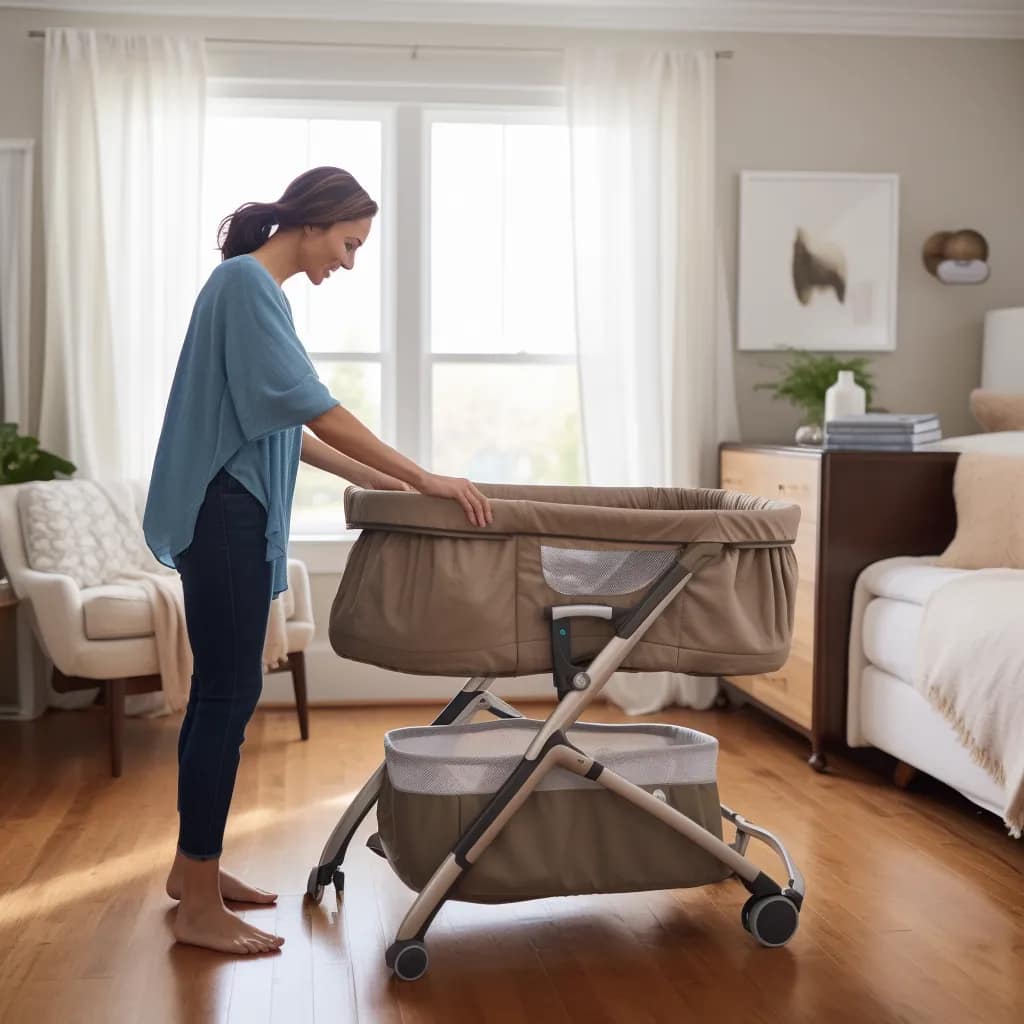To create a cozier bassinet for your baby, focus on temperature regulation, a firm mattress, soft bedding, and swaddling. Position the bassinet nearby your bed, ensuring your baby feels close and secure. By implementing these strategies, you’ll be well on your way to providing a snug sleep environment that your little one will love.

Ensuring your baby has a comfortable and safe sleeping environment is paramount for every parent. In this guide, we’ll delve deep into the art of crafting the perfect bassinet setup. From understanding the basics of bassinets to exploring advanced comfort techniques and safety precautions, we’ve got you covered. Whether you’re a first-time parent or a seasoned pro, you’ll discover invaluable tips and insights to transform your baby’s bassinet into a haven of restful slumber.
Hey there, fellow parents and soon-to-be-parents! Embarking on the parenting journey brings a mix of joy, challenges, and countless questions. One of the most pressing? Ensuring your little one gets the beauty sleep they need. Enter the world of bassinets—a cozy, snuggly nook designed just for them. As a mom of three with countless diaper changes and baby lullabies under my belt, I’m here to share tried-and-true techniques to make that bassinet a first-class snooze sanctuary. So, grab your favorite beverage, settle in, and let’s embark on this journey to dreamland together.
Understanding the Basics of Bassinets
What Is a Bassinet?
A bassinet stands as a miniature haven of slumber for our tiniest humans. It’s a snug, portable sleeping sanctuary explicitly designed for infants. This dainty space offers a cocoon-like comfort, making it the go-to choice to cradle your baby in snug serenity during those precious early months.
Exploring Bassinet Comfort Techniques
1. Regulate Temperature
The temperature dance can set the stage for sweet dreams. Striking the Goldilocks balance is the key. A room that’s neither sweltering nor chilly works wonders. Just think cozy sweater weather—perfect for your little one’s peaceful snooze.
2. Enhanced Section on Mattress Firmness
Optimal Mattress Firmness: The foundation of a comfortable bassinet lies in its mattress. While we all want our babies to sleep on a cloud-like surface, it’s essential to strike a balance. A mattress that’s too soft can pose risks, as it might mold around the baby’s face, leading to suffocation.
On the other hand, an overly firm mattress, although safe, might not offer the comfort your baby needs. Aim for a mattress that’s not too soft and not too firm but just right for your growing tot. A bassinet mattress with the ideal firmness creates a safe space for the baby to snooze, preventing any uneasy sinking or suffocation scares. When shopping, look for mattresses with certifications that ensure they meet safety standards.
3. Employ a Mattress Protector
In the realm of baby comfort, leaks and spills are bound to make appearances. That’s where the superhero of sleep, the mattress protector, comes in. This breathable knight in armor keeps the mattress dry and happy, while also letting the air breeze through for that extra touch of comfort.
4. Choose Fitted Sheets
Wrinkles and bunches are the enemies of slumber. Soft fitted sheets made from breathable materials? Now that’s a friend. They snuggle snugly around the mattress, ensuring a smooth and serene sleeping surface for your baby’s peaceful respite.
5. Swaddle for Security
Wrapping your little cherub in a gentle, breathable blanket is like giving them a snuggly embrace from the womb. The soothing snugness mimics the coziness they’re used to, all while keeping those tiny hips free to wiggle safely.
6. Introduce Sleeping Bags
When it’s time for a sleep adventure, consider a trusty sleeping bag tailored for bassinets. These snug cocoons are like a warm hug, without the fuss of loose bedding. It’s the happy medium between comfort and safety.
7. Close Proximity to Your Bed
For that extra sprinkle of nighttime enchantment, position the bassinet close to your bed. It’s like sharing a secret sleep society, making those midnight cuddles and feedings a breeze, all while fostering that heartwarming sense of closeness.
Bassinet Materials and Allergies: Choosing the Right Fabric for Sensitive Skin
Why Materials Matter
Babies have delicate skin that’s more permeable and sensitive than adult skin. This means they’re more susceptible to irritants, allergens, and rashes. The materials and fabrics used in bassinets can play a significant role in either preventing or exacerbating skin issues.
Common Bassinet Materials
Cotton:
A popular choice due to its softness and breathability. Organic cotton is often recommended as it’s grown without the use of pesticides or synthetic fertilizers, reducing the risk of skin irritations.
Polyester:
While durable and often more affordable, polyester is less breathable than cotton. It might not be the best choice for babies with very sensitive skin.
Bamboo:
An eco-friendly option that’s known for its softness, moisture-wicking properties, and natural hypoallergenic qualities.
Mesh:
Commonly used for the sides of bassinets to ensure breathability and visibility. It’s essential to ensure the mesh is fine and durable to prevent any safety hazards.
Tips for Parents
Read Labels: Always check the materials used in any bassinet or bedding product. Look for certifications like OEKO-TEX or GOTS, which indicate the product is free from harmful chemicals.
Wash Before Use: Before placing your baby in a new bassinet, wash all removable fabrics with a gentle, fragrance-free detergent. This removes any residues from the manufacturing process.
Monitor for Reactions: Regularly check your baby’s skin for signs of irritation, especially in areas in direct contact with the bassinet’s fabric. If you notice any redness or rashes, consider if the bassinet material might be the cause.
Consult a Pediatrician: If you’re unsure about the best materials for your baby or if your baby has a known skin condition, seek advice from a pediatrician.
Evolution of Bassinets: A Journey Through Time

The Ancient Beginnings
Bassinets, in various forms, have been around for centuries. Ancient civilizations, from the Egyptians to the Greeks, used woven baskets or similar structures to cradle their infants. These early bassinets were often made from natural materials like reeds or wicker and were designed for portability.
The Middle Ages and Renaissance
As societies evolved, so did the design of bassinets. During the Middle Ages and the Renaissance, bassinets became more ornate. Crafted from wood and often adorned with intricate carvings or fabrics, these bassinets were a symbol of status and were primarily used by the nobility.
The Industrial Revolution
The 18th and 19th centuries saw significant changes in bassinet design, thanks to the Industrial Revolution. With the advent of new materials and manufacturing processes, bassinets became more accessible to the general public. They began to feature stands, hoods, and even wheels, evolving into the designs we recognize today.
Modern Innovations
Today’s bassinets are a fusion of tradition and technology. While the primary purpose remains the same – providing a safe and comfortable space for infants – modern bassinets come equipped with features like vibration settings, built-in white noise machines, and even smart technology to monitor a baby’s sleep patterns.
The Future of Bassinets
As technology continues to advance, we can only imagine the innovations the future holds for bassinets. From self-rocking mechanisms to AI-powered sleep trackers, the possibilities are endless.
The Science of Sleep: Understanding Baby Sleep Patterns
The Unique Sleep Cycle of Babies
Unlike adults, babies have a distinct sleep cycle that evolves rapidly during their first year of life. Newborns spend a significant amount of time in REM (Rapid Eye Movement) sleep, which is crucial for brain development. As they grow, the proportion of non-REM sleep increases, leading to longer, more restful sleep periods.
The Importance of REM Sleep
REM sleep is not just essential for adults; it plays a pivotal role in a baby’s cognitive and neural development. During this phase, the brain processes experiences, consolidates memories, and stimulates the central nervous system. A comfortable bassinet can promote longer REM sleep phases, ensuring optimal brain development.
Sleep Environment and Quality
The environment in which a baby sleeps can significantly impact the quality of their sleep. Factors like room temperature, lighting, and the comfort of their bassinet play a role. A well-designed bassinet, with the right firmness and materials, can create an ideal sleep environment, promoting longer and more restful sleep.
Sleep Challenges and Solutions
Many parents face challenges with their baby’s sleep patterns, from frequent wake-ups to difficulty settling. Understanding the science behind these challenges can offer insights into potential solutions. For instance, a bassinet that mimics the gentle rocking motion a baby feels in the womb can help soothe and induce sleep.
The Link Between Sleep and Growth
It’s commonly said that babies grow in their sleep, and there’s science to back this up. Growth hormone is primarily secreted during deep sleep, emphasizing the importance of a good night’s rest for physical development.
Bassinet vs. Crib: Making the Right Choice for Your Baby
Both bassinets and cribs serve as sleeping spaces for babies, but they have distinct features, advantages, and ideal usage periods. Understanding the differences can help parents choose the most suitable option based on their needs and their baby’s age.
Bassinet Features and Benefits
Portability: Bassinets are lightweight and often come with wheels, making it easy to move them from room to room.
Size: They are smaller than cribs, making them ideal for parents with space constraints or those who want to keep their baby close during the initial months.
Duration of Use: Bassinets are typically used for the first 3-6 months, or until the baby starts to roll over or sit up.
Crib Features and Benefits
Durability: Cribs are designed to last for years, accommodating a child from infancy to toddlerhood.
Safety Standards: Modern cribs adhere to strict safety standards, ensuring a safe environment as the baby grows and becomes more mobile.
Adjustability: Many cribs come with adjustable mattress heights, allowing parents to lower the mattress as the baby grows.
Key Considerations When Deciding
Space: If you have limited space, a bassinet might be more suitable initially. However, consider the long-term benefits of investing in a crib.
Budget: Bassinets are generally less expensive than cribs, but their shorter usage duration might make a crib a more cost-effective choice in the long run.
Lifestyle: For families that travel frequently or move between rooms, a bassinet’s portability can be advantageous.
Transition: Consider the transition from bassinet to crib. Some babies adjust easily, while others might need a gradual transition.
What we can say about
Both bassinets and cribs have their merits. The decision largely depends on individual family needs, space, budget, and preferences. Regardless of the choice, ensuring the sleeping space adheres to safety standards is paramount.
Maintenance and Cleaning: Keeping Your Bassinet Fresh and Safe
The Importance of Regular Maintenance
A clean bassinet isn’t just about aesthetics; it’s crucial for your baby’s health. Babies, with their developing immune systems, are more susceptible to infections. Regular maintenance ensures the bassinet remains a safe and hygienic space for your little one.
Daily and Weekly Cleaning Tips
Spot Cleaning: Check the bassinet daily for any spills or stains. Using a damp cloth with mild soap, gently clean the affected area and let it air dry.
Sheet Changes: Just like adult bedding, bassinet sheets can accumulate dust, sweat, and other residues. Aim for a weekly change or more frequently if there are any spills.
Vacuuming: If your bassinet has fabric sides, use a vacuum cleaner with a soft brush attachment to remove dust and lint weekly.
Monthly Deep Cleaning
Dismantling: Every month, take apart the bassinet as much as the design allows. This gives you access to areas that might not be cleaned during regular maintenance.
Washing: Wash all removable fabrics in warm water using a gentle, fragrance-free detergent. Ensure they are thoroughly rinsed to remove all soap residues.
Frame Cleaning: Wipe down the bassinet’s frame, especially the corners and joints, using a mild soap solution. Ensure it’s thoroughly dried to prevent mold growth.
Safety Checks
Hardware: Monthly, check all screws, bolts, and other hardware to ensure they are tight and in place.
Stability: Ensure the bassinet remains stable, especially if it has a rocking or vibrating feature.
Wear and Tear: Check for any signs of damage, such as frayed fabric, broken parts, or any other potential hazards.
Storage Tips
If you plan to store the bassinet for future use, ensure it’s thoroughly cleaned and dried. Store in a cool, dry place, preferably in its original packaging or a breathable storage bag.
Incorporating Technology: The Modern Bassinet Revolution
The Fusion of Comfort and Technology
Today’s bassinets are not just about providing a comfortable sleeping space; they’re about optimizing the sleep experience. With the integration of technology, bassinets have transformed into smart sleep solutions that cater to both the baby’s and parents’ needs.
Features of Tech-Integrated Bassinets
Vibration and Rocking Mechanisms: Many modern bassinets come with built-in vibration or rocking features that mimic the soothing motions a baby feels in the womb, helping them settle and sleep better.
White Noise and Lullabies: Integrated sound systems can play calming white noise or lullabies, providing an auditory environment conducive to sleep.
Sleep Trackers: Some bassinets are equipped with sensors that monitor the baby’s sleep patterns, offering insights into their sleep quality and duration.
Temperature and Humidity Sensors: These sensors ensure the bassinet’s environment remains optimal, alerting parents if adjustments are needed.
Remote Control and Mobile Apps: Parents can control various bassinet features remotely, either through dedicated remotes or smartphone apps, allowing for adjustments without disturbing the baby.
Benefits of Tech-Integrated Bassinets
Personalized Sleep Solutions: Technology allows parents to tailor the sleep environment based on their baby’s preferences and needs.
Safety Enhancements: Features like motion sensors can alert parents if the baby makes unusual movements, adding an extra layer of safety.
Convenience for Parents: Remote controls and mobile apps mean parents can make adjustments without always needing to be right next to the bassinet.
Things to Consider
While technology offers many benefits, it’s essential to ensure:
Safety Standards: Any tech-integrated bassinet should meet safety standards and be free from potential hazards.
Reliability: Ensure the technology is reliable and doesn’t malfunction, which could disturb the baby’s sleep.
Battery and Power: Consider how the bassinet is powered, whether it’s battery-operated or needs a power outlet, and ensure it’s feasible for your setup.
Cultural Practices and Bassinets: A Global Perspective on Infant Sleep
The Universal Importance of Sleep
Across cultures and continents, the importance of ensuring a safe and comfortable sleep environment for infants is a shared concern. However, the methods, designs, and traditions surrounding this can vary widely, reflecting the rich tapestry of global cultural practices.
Notable Cultural Practices
Moses Baskets in Africa: Originating from the biblical story of Moses, these baskets, often made from papyrus or wicker, serve as portable sleeping spaces for infants in many African cultures.
Hammocks in Latin America: In countries like Brazil and Mexico, it’s common to see babies sleeping in hammocks, which are believed to mimic the gentle rocking motion experienced in the womb.
Kangaroo Care: Originating from Colombia, this practice involves skin-to-skin contact between the baby and parent, emphasizing the importance of physical closeness for sleep and development.
Hanging Cradles in Scandinavia: In some Nordic cultures, cradles are suspended from the ceiling, allowing for a gentle rocking motion that can soothe babies to sleep.
Futons in Japan: Instead of elevated cribs or bassinets, it’s common for babies in Japan to sleep on futons placed directly on the floor, believed to be safer and more communal.
The Underlying Themes
While the methods vary, several themes are consistent across cultures:
Safety: Every culture prioritizes the safety of the infant in their unique way, whether it’s the secure design of a Moses basket or the communal sleeping arrangements in Japan.
Comfort: The designs, whether a hanging cradle or a hammock, aim to provide maximum comfort to the baby, often mimicking the sensations felt in the womb.
Tradition: Many of these practices are steeped in tradition, passed down through generations, and hold significant cultural importance.
Embracing Diversity
Understanding these diverse practices can offer new parents a broader perspective and even inspire them to incorporate elements from various cultures into their baby’s sleep routine.
Ensuring the Safety of Your Bassinet
Safety should always be the top priority when it comes to your baby. Ensuring that the bassinet is safe not only provides peace of mind but also guarantees a secure environment for your little one.
Safety Precautions
When setting up and using a bassinet, it’s essential to adhere to the following precautions:
Stability: Ensure the bassinet has a sturdy base and won’t tip over easily.
No Gaps: There shouldn’t be any gaps larger than two fingers between the mattress and the sides of the bassinet.
Firm Mattress: The mattress should be firm to reduce the risk of Sudden Infant Death Syndrome (SIDS).
Avoid Overhead Toys: Hanging toys can be a choking hazard if they fall or are pulled into the bassinet.
Keep It Bare: Avoid placing pillows, stuffed animals, or heavy blankets in the bassinet.
Regular Checks and Maintenance
Routine checks ensure the bassinet remains in optimal condition:
Hardware: Monthly, check all screws, bolts, and other hardware to ensure they are tight and in place.
Cleanliness: Regularly clean the bassinet, ensuring no mold or bacteria growth.
Wear and Tear: Check for any signs of damage, such as frayed fabric, broken parts, or any other potential hazards.
Addressing Common Safety Concerns
Parents often have concerns about various aspects of bassinet safety. Here’s how to address them:
Breathability: Ensure the bassinet’s sides are made of breathable material, especially if they are fabric or mesh.
Weight Limit: Always adhere to the manufacturer’s weight limit. Once a baby exceeds this limit, it’s time to transition to a crib.
Location: Place the bassinet in a safe location, away from windows, blinds, or heaters.
The Benefits of Bassinets for Your Baby

Bassinets have been a staple in infant care for centuries, and for good reason. Beyond their aesthetic appeal and compact size, they offer a range of benefits tailored to the unique needs of newborns and their caregivers.
Comfort and Security

Bassinets are designed with the utmost comfort and security in mind. Their cozy and confined space mimics the womb’s environment, providing babies with a sense of familiarity and safety.
Snug Environment: The compact design of a bassinet offers a snug fit, making babies feel secure and protected.
Soft Linings: Many bassinets come with soft, cushioned linings that provide a gentle touch against a baby’s delicate skin.
Enclosed Design: The sides of a bassinet act as a barrier, ensuring the baby doesn’t roll out, offering parents peace of mind.
Portability and Convenience

One of the standout features of bassinets is their portability, making them a favorite choice for parents on the move.
Lightweight: Bassinets are typically lighter than cribs, making them easy to carry from room to room.
Compact Size: Their smaller size means they can fit in tight spaces, perfect for parents with limited room or those who travel.
Easy Setup: Most bassinets are easy to assemble and disassemble, making them convenient for trips or visits to grandparents.
Versatile Mobility Features: With wheels or handles, bassinets ensure that the snug embrace of slumber knows no bounds, accompanying your baby’s dreams from room to room.
Sleep Quality and Developmental Benefits

A good night’s sleep is crucial for a baby’s development, and bassinets play a pivotal role in ensuring this.
Reduced Disturbances: The enclosed design of a bassinet reduces external disturbances, ensuring a sound sleep for the baby.
Familiar Environment: The consistency of a bassinet provides a familiar sleep environment, helping babies establish a sleep routine.
Developmental Support: Quality sleep in a bassinet aids in physical growth, cognitive development, and emotional well-being.
Budget-Friendly

Championing the cost-effective crusade, bassinets shine as the wallet-friendly winners. Their gentle price tags make them an economic favorite among parents, proving that cozy dreams don’t have to break the bank.
Space Efficiency

In the realm of baby care, space is often at a premium. Bassinets play a pivotal role in maximizing space. Their compact size is tailor-made for cozy quarters, ensuring your baby can snooze comfortably, even in the smallest spaces.
Added Storage

Some bassinets harbor a hidden treasure—built-in storage compartments. These convenient nooks offer sanctuary to baby essentials, keeping everything organized and within arm’s reach.
As we’ve explored the myriad benefits of bassinets, it’s also essential to understand how to ensure a peaceful night for your baby.
Calming a Restless Baby at Night
Techniques for Soothing a Fussy Baby

Every baby has their unique rhythm, and sometimes, the night can be filled with restlessness. Discover techniques to lull and calm your little one, ensuring peaceful dreams for both baby and parent.
Frequently Asked Questions (FAQs)
Are Bassinets Safer Than Cribs?
As you navigate the realm of sleep sanctuaries, ponder the safety of bassinets versus cribs. Unravel the considerations, ensuring that your choice aligns with your baby’s restful journey.
Can You Put a Newborn in a Bassinet Unswaddled?
Delve into the safety of placing your newborn in a bassinet sans swaddling. Arm yourself with knowledge as you create a haven that balances comfort and well-being, all while embracing the uniqueness of your tiny dreamer.
Crafting the Ultimate Comfort for Your Baby’s Bassinet
Adding Extra Comfort with Padding
Every parent wants to provide the utmost comfort for their baby. However, when it comes to bassinets, there’s a fine line between comfort and safety. While a touch of plushness can indeed make all the difference, it’s crucial to approach padding with caution. Adding too much or the wrong type can lead to increased risks, such as suffocation or overheating. If you’re considering a padding layer, opt for thin, breathable materials specifically designed for bassinets. These materials should provide gentle support without compromising safety. Always ensure that any added padding fits the bassinet snugly, leaving no gaps or loose areas where the baby could become trapped.
Addressing Sleep Struggles: What To Do When Your Baby Dislikes the Bassinet
Oh, the mysteries of the baby mind! If your little one seems to give the side-eye to their bassinet, fear not. Experiment with short, positive interactions near the bassinet during playtime. Gradually increase their comfort level with the space before bedtime. Patience and a sprinkle of baby magic can work wonders.
Finding Solutions to Uncomfortable Nights in the Bassinet
For those pesky nights when sleep eludes your baby, consider using a bassinet that allows gentle rocking or swaying motions. The rhythmic movement mimics the womb’s sensation, often helping babies drift into dreamland faster. Just remember to follow safety guidelines for motion-based sleep solutions.
Unraveling the Mystery of Bassinet Mattress Firmness
It’s all about that Goldilocks balance! Aim for a mattress that’s neither too firm nor too soft. Your baby’s safety and comfort depend on a mattress that provides proper support while avoiding sinking or suffocation risks. Always choose quality over trendiness.
Understanding Newborn Inserts: Safety and Benefits
Newborn inserts can seem like the cozy nest your baby deserves, but remember that safety comes first. Opt for inserts specifically designed for bassinets, ensuring they provide proper back and neck support. And when in doubt, consult with your pediatrician for the green light.
Blanket Safety: Enhancing Comfort Without Compromising Safety
A blanket’s warmth can be comforting, but loose bedding is a no-go. Instead, consider swaddle blankets or sleep sacks to keep your baby snug. If a blanket is necessary, tuck it firmly under the mattress, ensuring your baby’s face remains uncovered during sleep.
Discovering the Optimal Sleep Position for Your Baby’s Bassinet
Curled up, sprawled out, or somewhere in between – babies have their preferred sleep positions. While back sleeping is recommended to reduce the risk of Sudden Infant Death Syndrome (SIDS), observing your baby’s natural sleeping posture can guide you in arranging their bassinet for ultimate comfort.
Normalizing Newborns’ Reactions to Bassinets: Is Resistance Typical?
Curious about those tiny protests your baby seems to stage against their bassinet? Relax, it’s perfectly normal. Babies often need time to adjust to new environments. Gradual exposure, soft lighting, and a dash of lullaby charm can transform that resistance into sleep-time acceptance.
Exploring the Effects of Allowing Babies to Cry in Their Bassinets
It’s the heart-wrenching melody no parent enjoys: baby cries. While soothing and nurturing are our first instincts, sometimes a brief, controlled cry in the bassinet can lead to self-soothing and sleep independence. But remember, every baby is different, so trust your parental instincts.
Tackling the Causes of Newborn Tossing and Turning in a Bassinet
Babies have a way of making even the most comfortable spot seem like a tossing-and-turning adventure. Common culprits? Gas, colic, or even just an exploratory phase. Consult your pediatrician to rule out underlying issues, and explore gentle techniques like burping and swaddling for better sleep.
Navigating Separation Anxiety: How It Affects Babies in Bassinets
Separation anxiety can make bedtime a tricky tango. Gradually introduce your baby to the bassinet during playtime, making it a cozy and positive space. Implement a consistent bedtime routine that includes soothing activities, ensuring your baby associates the bassinet with comfort and safety.
To Pad or Not to Pad? The Case for Mattress Pads in Bassinets
A mattress pad can provide an extra layer of cushioning, but ensure it’s thin and breathable. Steer clear of excessively soft padding that might pose suffocation risks. Choose a pad designed specifically for bassinets, and remember, your baby’s safety is the priority.
The Quest for the Goldilocks Firmness: Ideal Bassinet Mattress Feel
A bassinet mattress should be just right—firm enough to support your baby’s growing body but comfortable enough to ensure restful sleep. Check manufacturer recommendations and consult with pediatricians to find the perfect balance between safety and comfort.
From the ancient corridors of history to the modern nurseries of today, bassinets have stood the test of time as a beloved companion for newborns and their caregivers. They are not just a symbol of aesthetic elegance but also a testament to the evolving understanding of infant care.
Prioritizing comfort, safety, and convenience, bassinets have continually adapted to the changing needs of families. Whether you’re drawn to their portability, their snug design that mimics the womb, or the innovative features that modern technology has introduced, there’s no denying the invaluable role they play in the early stages of a child’s life.
As we’ve journeyed through the multifaceted world of bassinets in this article, one thing remains clear: the well-being of our little ones is paramount, and bassinets, in all their varied forms, are here to ensure just that. As you embark on the beautiful journey of parenthood, may the insights from this guide help you make informed choices, ensuring peaceful dreams and cherished moments with your precious bundle of joy.

